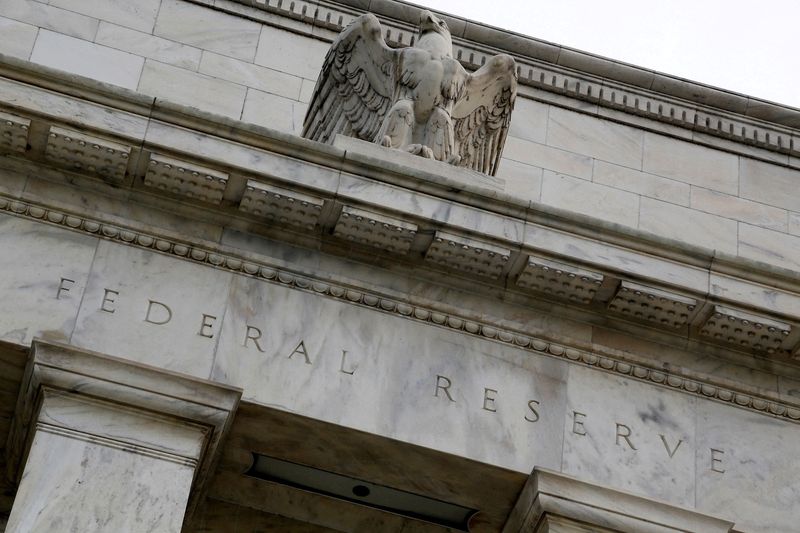LONDON (Reuters) - The Bank of England on Thursday raised interest rates for the third time in a row, a day after U.S. rates were lifted for the first time since 2018 in a sign that major central banks are determined to tame inflation even in the face of growth risks.
Russia's invasion of Ukraine has darkened the outlook for the global economy by causing a surge in energy and food prices that spells more pain for consumers and businesses.
So while many are focused on containing inflation, they are also wary of the fallout from the conflict. Here's a look at where policymakers stand on the path out of pandemic-era stimulus, ranked in terms of hawkishness.
Graphic: Central bank balance sheets about to get a touch smaller: https://fingfx.thomsonreuters.com/gfx/mkt/klpykbllrpg/CBANKBALANCESHEET.PNG
1) NORWAY
Norway started its rates lift-off in September and hiked its key rates again in December, to 0.5%.
Norges Bank is expected to hike again on March 24. Nordea expects four rate hikes this year.
2) NEW ZEALAND
The Reserve Bank of New Zealand last month raised its key rate by 25 basis points to 1% and forecast a higher peak in the tightening cycle.
It has said more work needs to be done to control inflation and that it's too early to assess the impact, if any, of the Russian invasion on policy -- a reminder that the central bank is one of the most hawkish among developed countries.
Markets are confident of a 0.5% increase in April, and expect rates to hit 2.75% by year-end.
Graphic: New Zealand's key rate rises to 1%: https://fingfx.thomsonreuters.com/gfx/mkt/zgvomzwdevd/NZrates.PNG
3) BRITAIN
The Bank of England raised its key rate by 25 bps to 0.75% on Thursday in its third straight increase. But with the economy facing a hit from soaring energy prices, it softened its language on the need for further increases.
The pound slumped almost a cent against the dollar and British government bond yields fell sharply as investors trimmed their bets that the BoE would raise rates rapidly this year.
Graphic: UK inflation surge: https://fingfx.thomsonreuters.com/gfx/mkt/zjvqkorgkvx/UKINFLATION.PNG
4) UNITED STATES
The U.S. Federal Reserve on Wednesday hiked its key rate by a quarter point to a range of 0.25%-0.5% and laid out an aggressive plan to tighten monetary policy in a bid to tame inflation, running at almost 8%.
Most policymakers now see the federal funds rate rising to a range between 1.75% and 2% by the end of 2022, the equivalent of a quarter-percentage-point rate increase at each of the Fed's six remaining policy meetings this year.
May is now seen by analysts as a "live date" to start unwinding quantitative easing.
Graphic: U.S. joins the rate hike club: https://fingfx.thomsonreuters.com/gfx/mkt/dwpkrlxngvm/RATES1703.PNG
5) CANADA
On March 2, the Bank of Canada raised its key rate by a quarter point to 0.5%, the first rate rise since October 2018.
Global uncertainty is unlikely to sway it from its battle to contain inflation running at 30-year highs. BoC chief Tiff Macklem says there is "considerable space" left to hike rates this year and doesn't rule out a 50 bps move.
Graphic: Canada hikes interest rates: https://fingfx.thomsonreuters.com/gfx/mkt/dwpkrlynnvm/CANADA0903.PNG
6) AUSTRALIA
The Reserve Bank of Australia kept rates at a record low 0.1% at its March 1 meeting, citing the Ukraine crisis as a new source of uncertainty.
After ending its bond-buying scheme last month, the RBA has pushed back against expectations for an early rate rise. Its dovish stance has been cemented by the war, even though the economy is growing faster than predicted.
7) EURO ZONE
The ECB plans to end asset purchases in the third quarter, accelerating its exit from extraordinary stimulus, predicting inflation to average 5.1% in 2022, more than double its target.
The Russia conflict is expected to have a "material impact" on economic activity, and the ECB believes any interest rate adjustments will take place "some time" after the end of asset buys. They would be "gradual", it added.
Markets are pricing in almost 50 bps of tightening by year-end, equivalent to five 10-bps hikes.
Graphic: Russia's attack on Ukraine a headwind for Europe: https://fingfx.thomsonreuters.com/gfx/mkt/dwvkrlqogpm/banks0803.PNG
8) SWEDEN
Surging inflation means that Sweden's central bank may need to bring forward its first rate hike since the pandemic began, Governor Stefan Ingves said on Wednesday.
Headline inflation hit 4.5% in February and, excluding volatile energy prices, was running at 3.4% - it's highest level since 1993.
Sweden's Riksbank has pencilled in a rate hike for 2024, which Ingves says might be a "bit too far off." Economists expect as many as two rate hikes this year.
9) JAPAN
Japan is unlikely to see inflation hitting its central bank target of 2%, even accounting for rising energy costs, Bank of Japan Governor Haruhiko Kuroda said on Thursday, making the case for keeping monetary policy ultra-easy.
The BOJ's dovish stance makes it an outlier as more of its central bank peers eye rate rises.
Graphic: Japan assets: https://fingfx.thomsonreuters.com/gfx/mkt/gkplgakonvb/Japanassets.JPG
10) SWITZERLAND
The Swiss National Bank remains at the dovish end of the spectrum, seeing its stance as appropriate even with inflation hitting 2.2% in February, the highest since 2008.
Safety-seeking flows sparked by the Ukraine conflict have pushed the Swiss franc to its strongest levels against the euro since January 2015, when the SNB scrapped its currency peg.

While franc strength helps contain inflation, the pace of the move has caused unease, prompting a rare verbal intervention from the SNB about the franc.
Graphic: chfintervention: https://fingfx.thomsonreuters.com/gfx/mkt/mypmnxyeevr/chfintervention.JPG